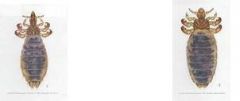![]()
![]()
![]()
Use LEFT and RIGHT arrow keys to navigate between flashcards;
Use UP and DOWN arrow keys to flip the card;
H to show hint;
A reads text to speech;
52 Cards in this Set
- Front
- Back
|
1. Biting – Mallophaga
2. Sucking – Anoplura |
Two types of lice
|
|
|
lice of large animals
|
Pediculosis
|
|
|
type of biting louse (Mallophaga) affects cattle
|
Pediculosis
|
|
|
Cattle Biting Louse
|
Damalinia (Bovicola) bovis
|
|
|
1.Short Nose Cattle Louse – Haematopinus eurysternus
2.Long Nose Cattle Louse – Linognathus vituli 3.Little Blue Cattle Louse – Solenopotes capillatus |
3 species of sucking lice (Anoplura)
|
|
|
Short Nose Cattle Louse
|
Haematopinus eurysternus
|
|
|
Long Nose Cattle Louse
|
Linognathus vituli
|
|
|
Little Blue Cattle Louse
|
Solenopotes capillatus
|
|
|
Cattle lice
Short nose cattle louse and long nose cattle louse |

.
|
|
|
Cattle lice
Little blue cattle lice |

.
|
|
|
Cattle lice
Cattle biting lice and nits (damalinia bovis) |

.
|
|
|
1. The Horse Biting Louse – Damalinia (bovicola) equi
2. The Horse Sucking Louse – Haematopinus asine |
Horses
Harbor 2 species of lice |
|
|
Damalinia (bovicola) equi
|
The Horse Biting Louse
|
|
|
Haematopinus asine
|
The Horse Sucking Louse
|
|
|
The Hog Louse
|
Pediculosis in pigs
|
|
|
The Hog Louse
|
Haematopinus suis
|
|
|
This is a very large louse 5-6mm
|
The Hog Louse
|
|
|
sheep species of biting louse
|
Mallophaga
|
|
|
Sheep Biting Louse
|
Damalinia (Bovicola) ovis
|
|
|
3 species of sucking lice (Anoplura)
|
1. The Sheep Foot Louse – Linognathus pedalis
2. The Body Louse – L. ovillus 3. African Sheep Louse – L. africanus |
|
|
The Sheep Foot Louse
|
Linognathus pedalis
|
|
|
The Body Louse
|
L. ovillus
|
|
|
African Sheep Louse
|
L. africanus
|
|
|
Horse lice
Biting lice and nits (Damalinia equi) |

.
|
|
|
Horse lice
Sucking lice (Haematopinus asine) |

.
|
|
|
Pig lice
Sucking lice (Haematopinus suis) |

.
|
|
|
Sheep
Biting lice (Damalinia ovis) |

.
|
|
|
Sheep
Sucking lice Sheep foot louse (Linognathus Pedalis), Body louse (L. ovillus), and (L. africanus) |

.
|
|
|
Harbor many species of lice the most common being
1. The Goat Biting Louse – Dramalinia (Bovicola) caprae 2. The Goat Sucking Louse – Linognathus stenopsis |
Prediculosis
Goats |
|
|
The Goat Biting Louse
|
Dramalinia (Bovicola) caprae
|
|
|
The Goat Sucking Louse
|
Linognathus stenopsis
|
|
|
Two other mallophaga lice that are frequently found
in goats |
1. D. limbarta
2. D. crassipes |
|
|
manifest by pruitus and dermal irritation which results in scratching, rubbing, and biting at infested areas.Rough coat, and lowered production in farm animals are common.
Extreme infestation with sucking lice can cause anemia. |
Goat Prediculosis
|
|
|
Goat Sucking and biting lice of goats
|

.
|
|
|
Diagnosis is based upon presence of lice.
|
Prediculosis
|
|
|
The hair on large animals should be parted on the face, neck, ears, topline, dewlaps, tail base, to look for lice.
|
Prediculosis
|
|
|
The head, legs, feet, and scrotum should not be over looked especially in sheep.
|
Prediculosis
|
|
|
most prevalent during the winter in livestock
|
Prediculosis
|
|
|
requires application of effective insecticides (dips and sprays)
|
Louse control
|
|
|
Backrubber devices
|
dust bags
|
|
|
is effective against sucking lice
|
Injectable ivermectin
|
|
|
1. egg
2. larva 3. nymph 4. adult |
Mange in Cattle (barn itch)
Developmental Stages: |
|
|
They are host specific
Identification by recovery of mite in skin scraping |
Mange
|
|
|
Scabies
|
Sarcoptes scabiei var bovis
|
|
|
Lesions firs appear on the head and neck then spread to other parts
Skin irritation and eruptions are characterized by a squamous, crusted appearance the skin thickens and forms large folds. |
Mange
|
|
|
Is a notifiable and quarantinable disease when suspected it must be reported immediately.
|
Common scabies or psoroptic mange of cattle (Psoroptes ovis)
|
|
|
In the USA owners should not attempt to treat cattle infested with psoroptic mange this must be done by government officials.
|
Common scabies or psoroptic mange of cattle (Psoroptes ovis)
|
|
|
Seen in range and feedlot cattle.
|
Common scabies or psoroptic mange of cattle (Psoroptes ovis)
|
|
|
It appears first on the withers and soon spreads, along the neck and back, and over the shoulders, brisket to the belly and flanks.
|
Common scabies or psoroptic mange of cattle (Psoroptes ovis)
|
|
|
Infested cattle should be dipped not sprayed may need repeat dipping at intervals of 7-14 days
|
Common scabies or psoroptic mange of cattle (Psoroptes ovis)
|
|
|
Ivermectin S.Q. at 200 micrograms/kg body wt. is approved for control of psorotic and sarcoptic mange (not in lactating dairy cattle)
|
Common scabies or psoroptic mange of cattle (Psoroptes ovis)
|
|
|
Is the most common type of mange in cattle in the USA
|
Chorioptic mange (chorioptes bovis)
|

